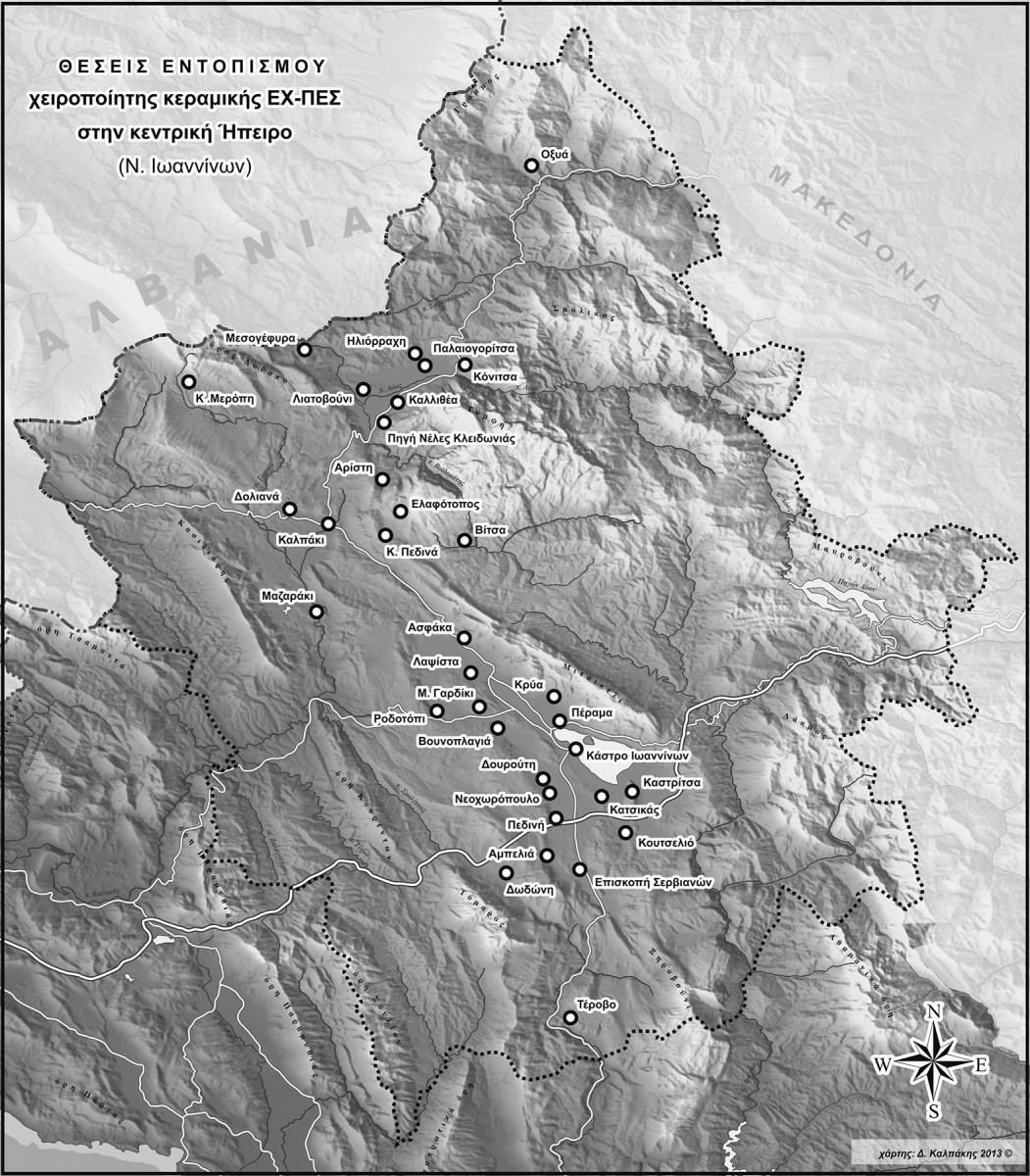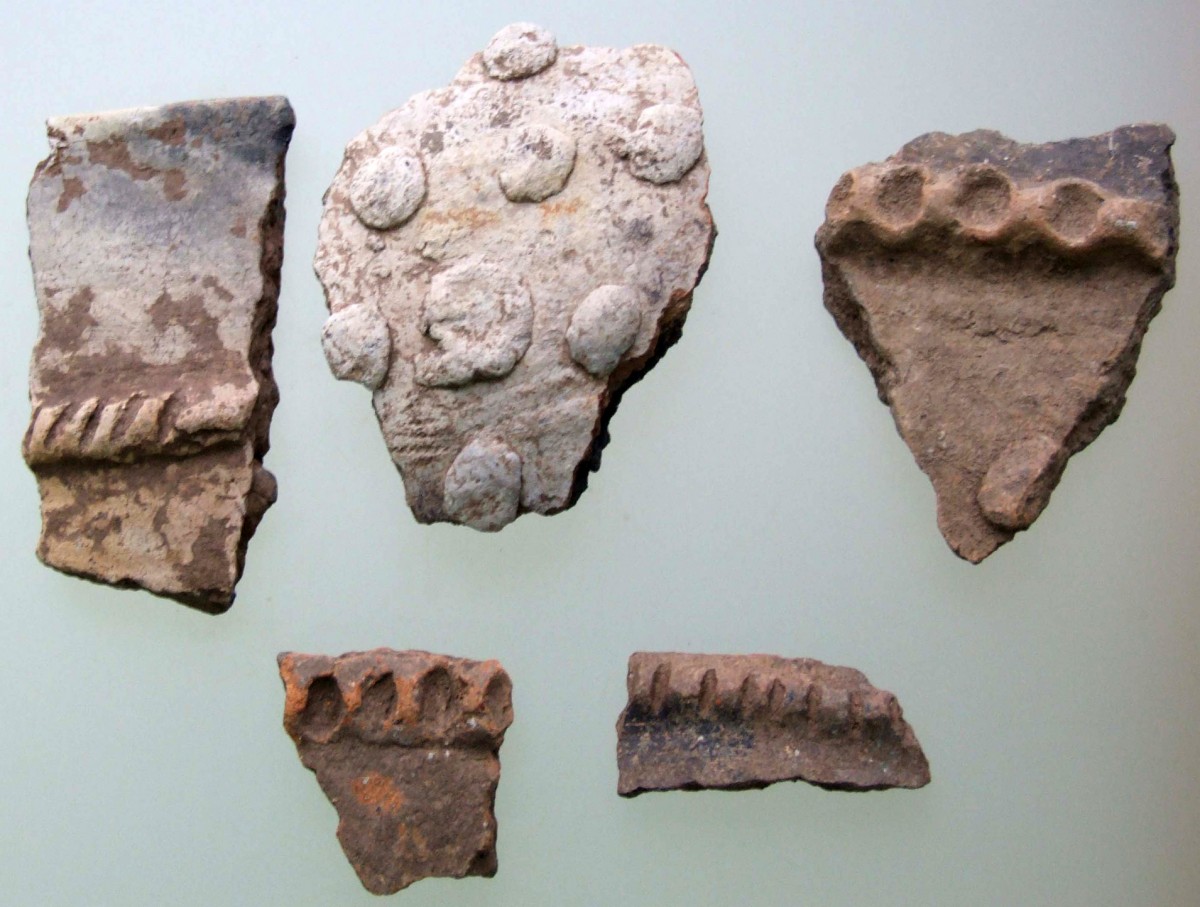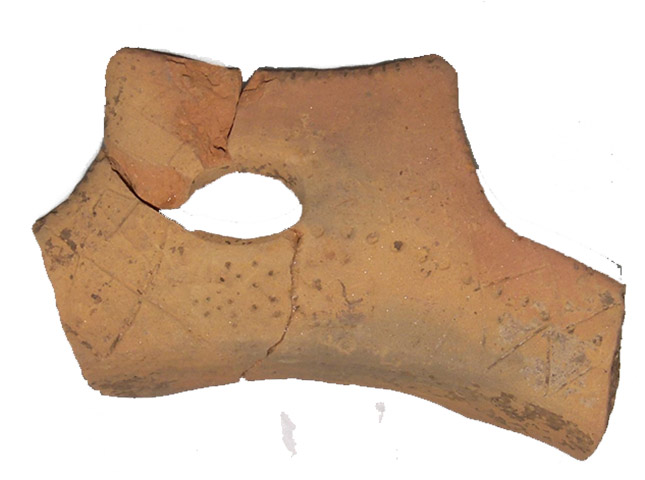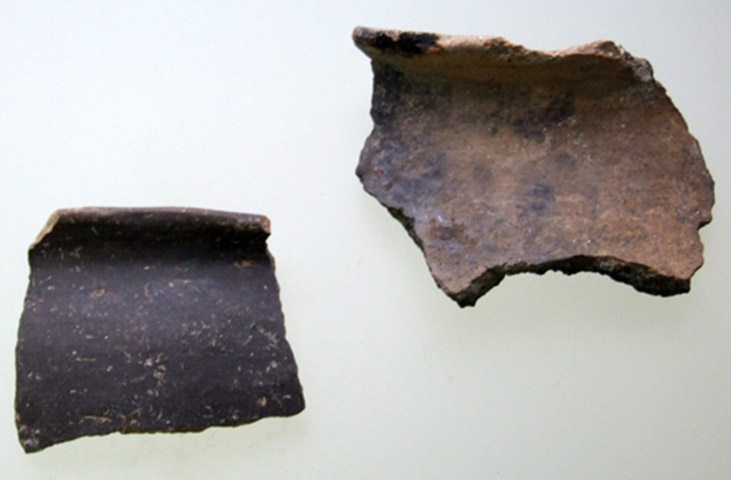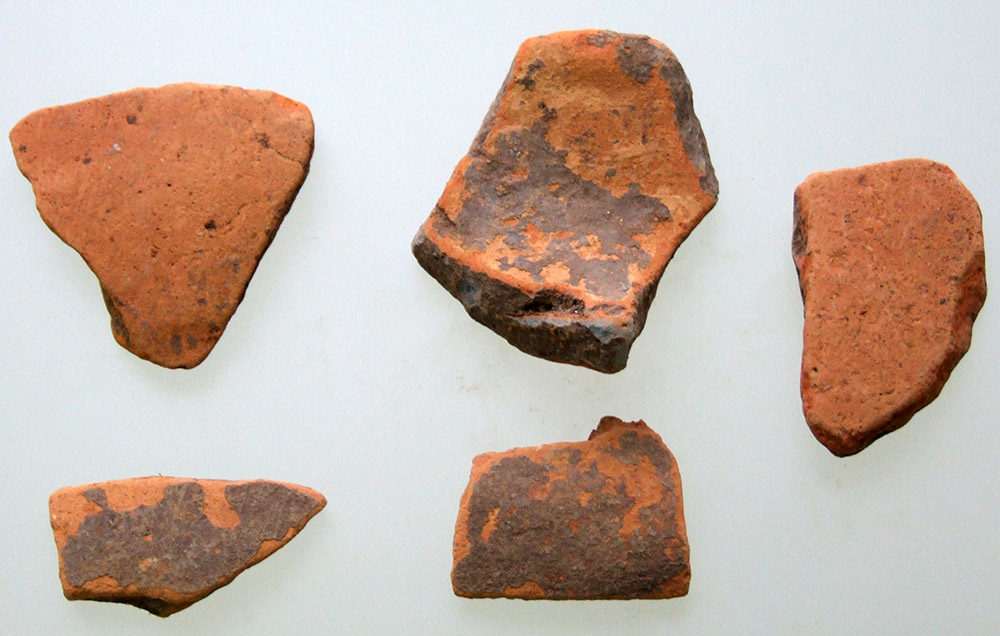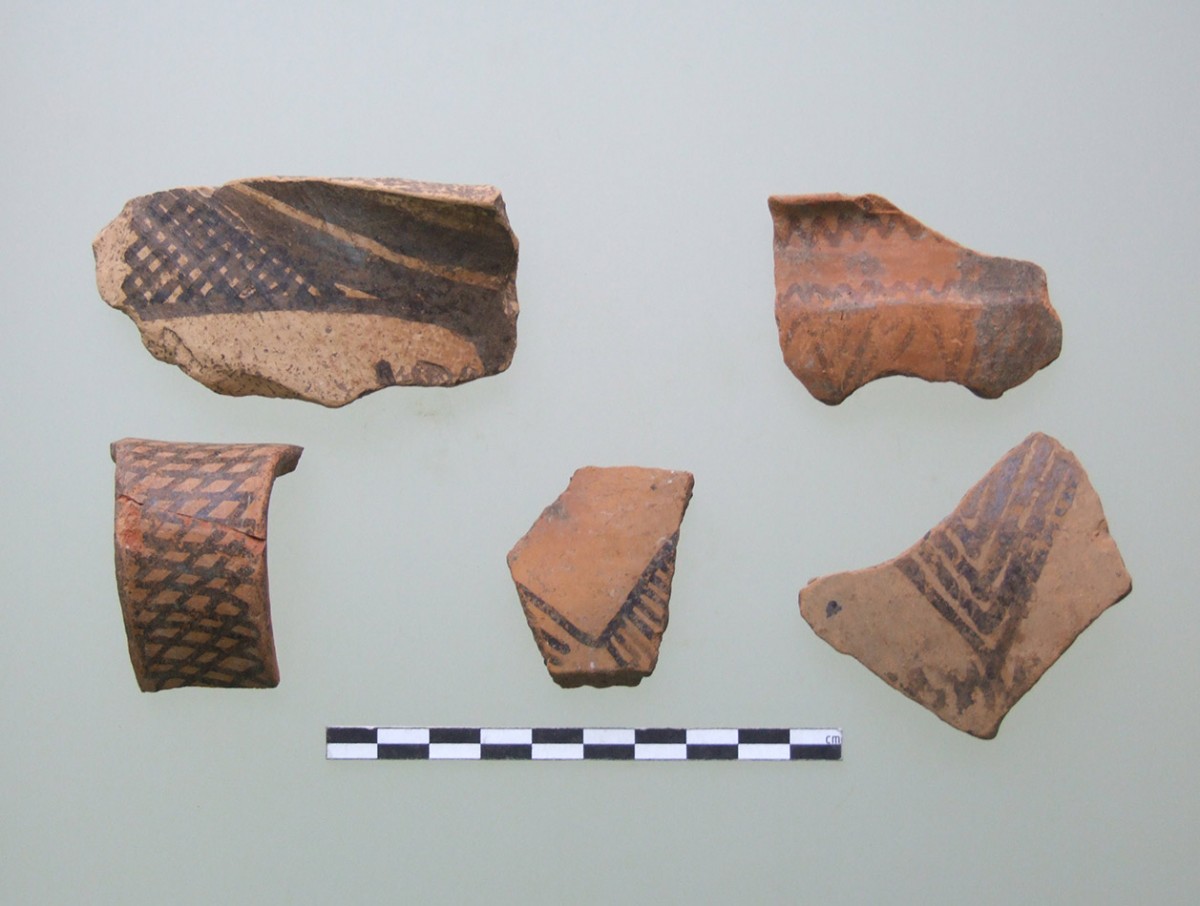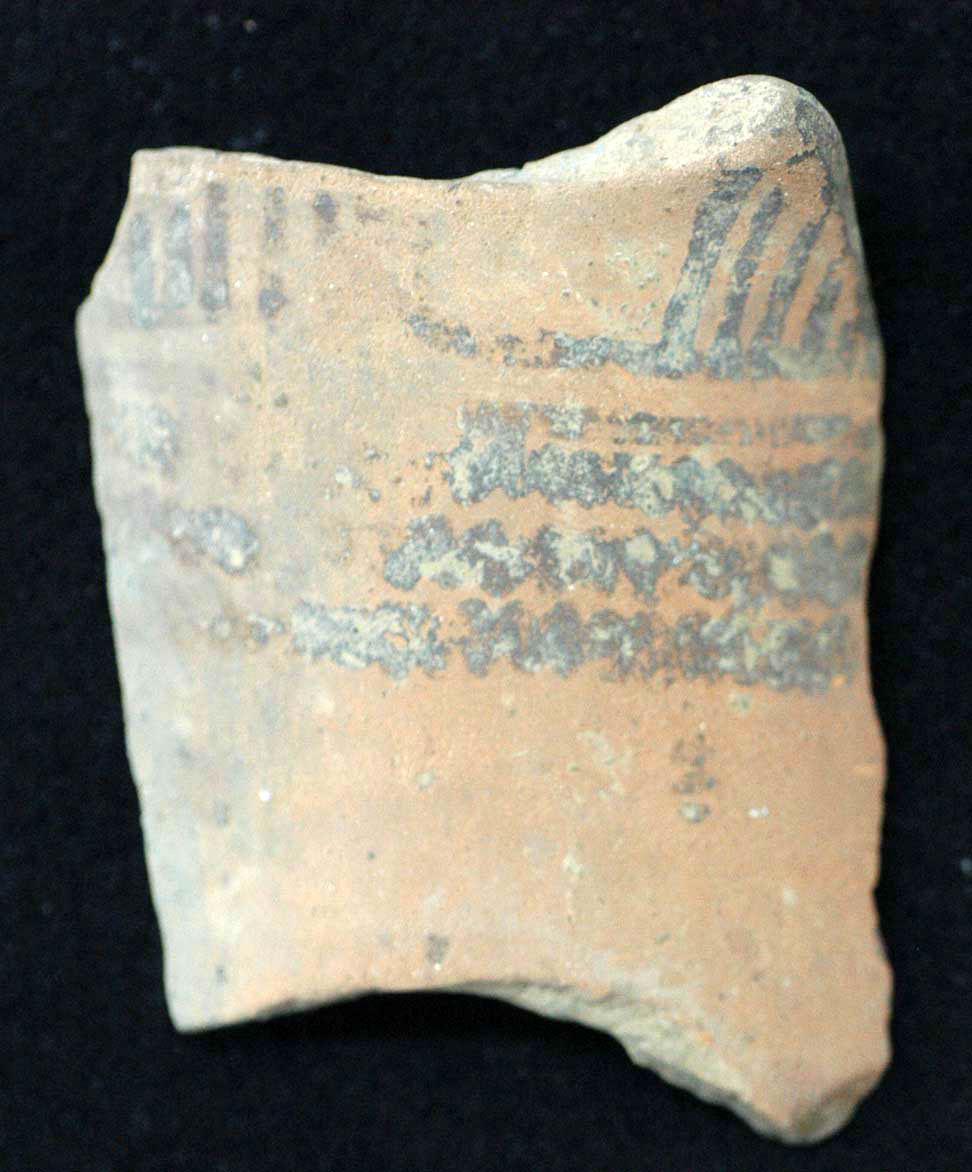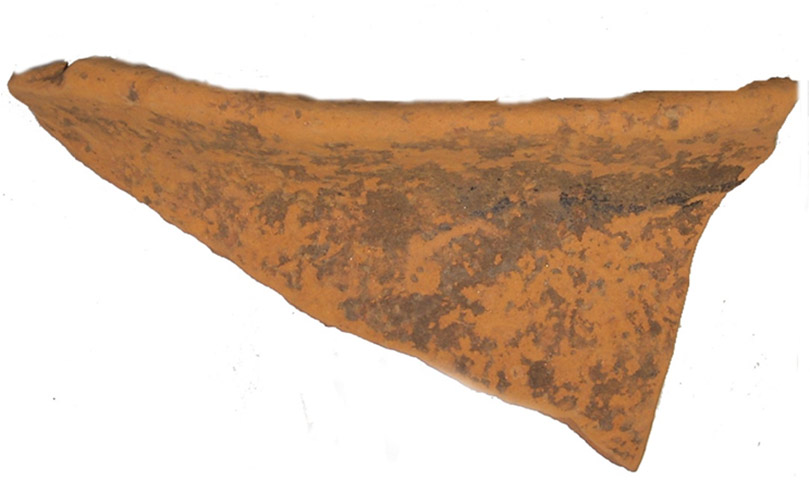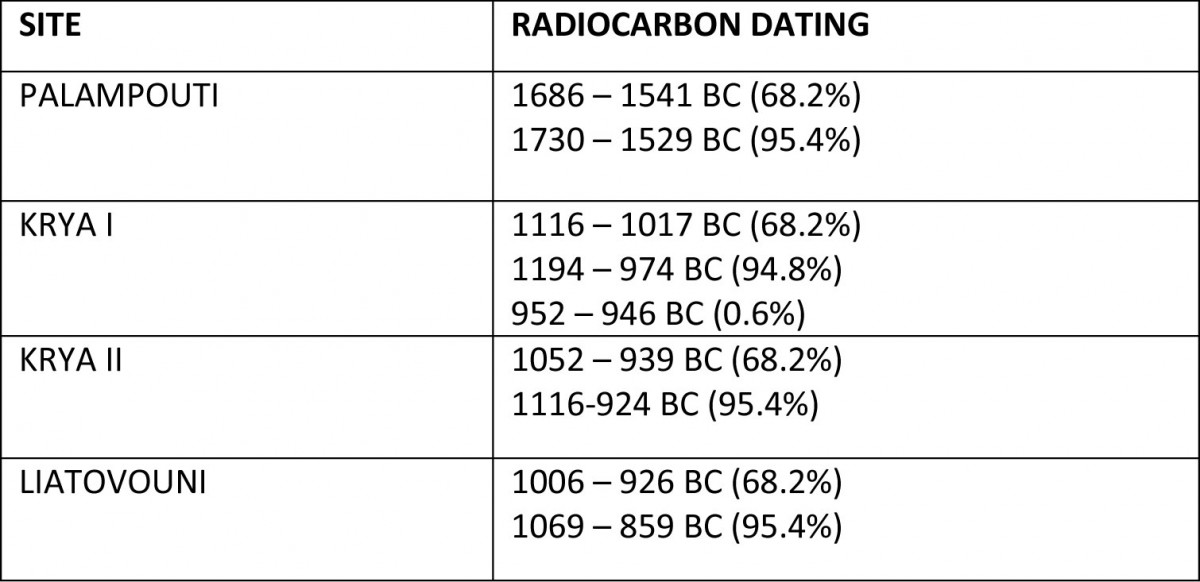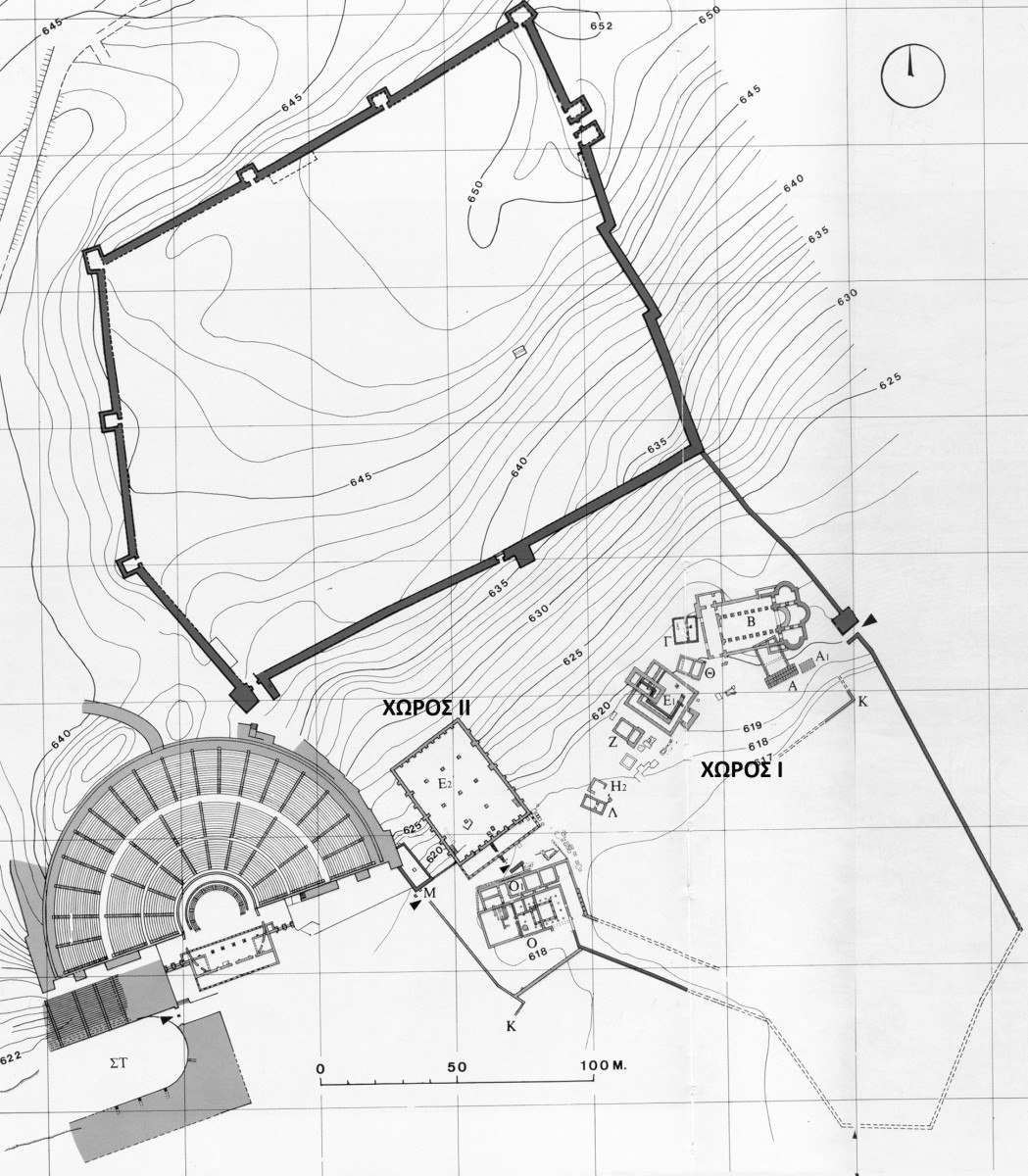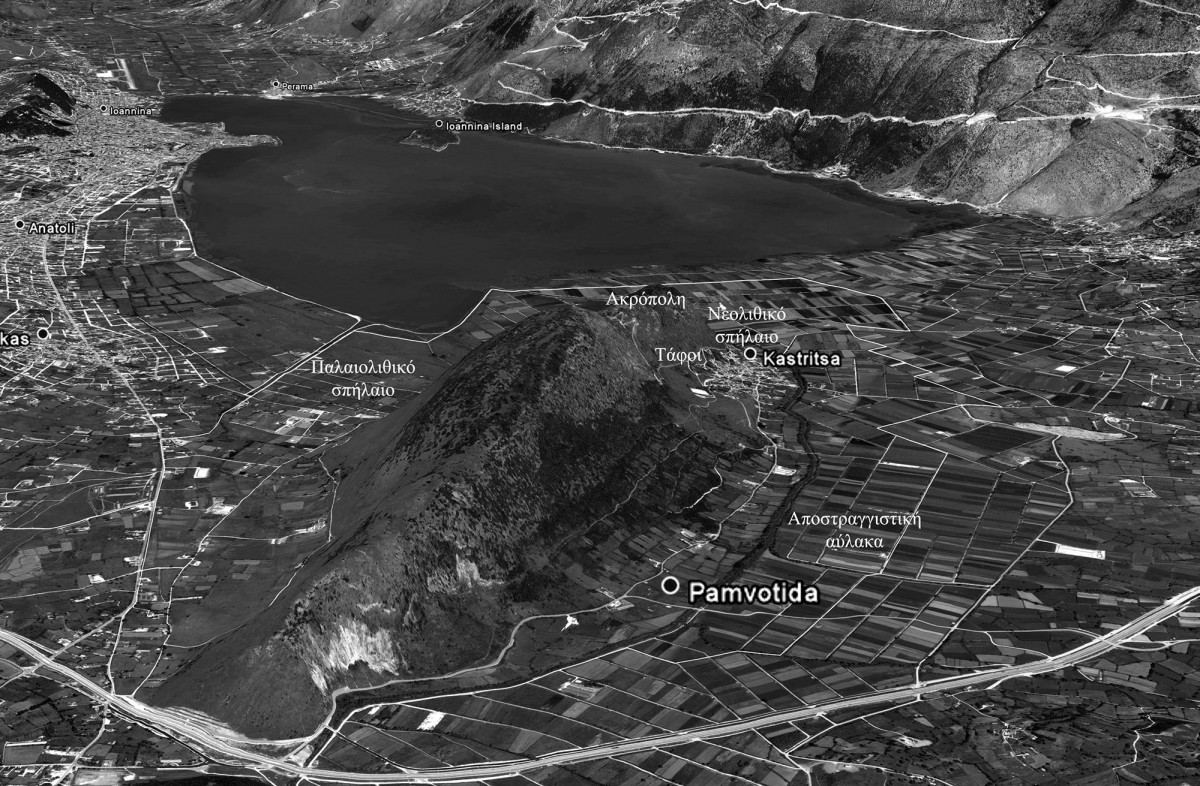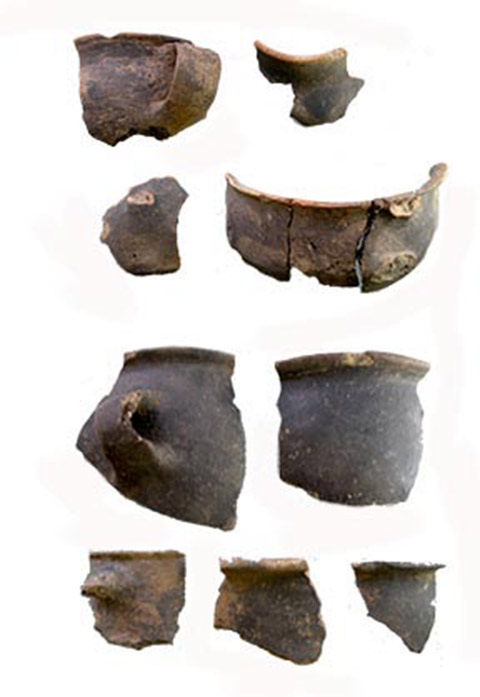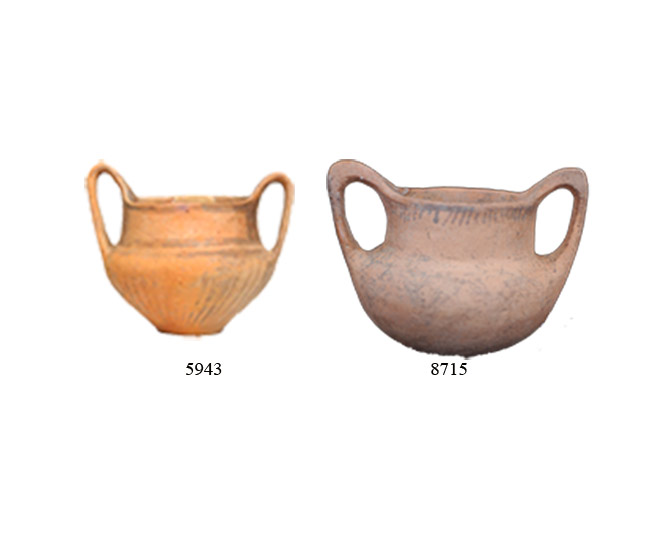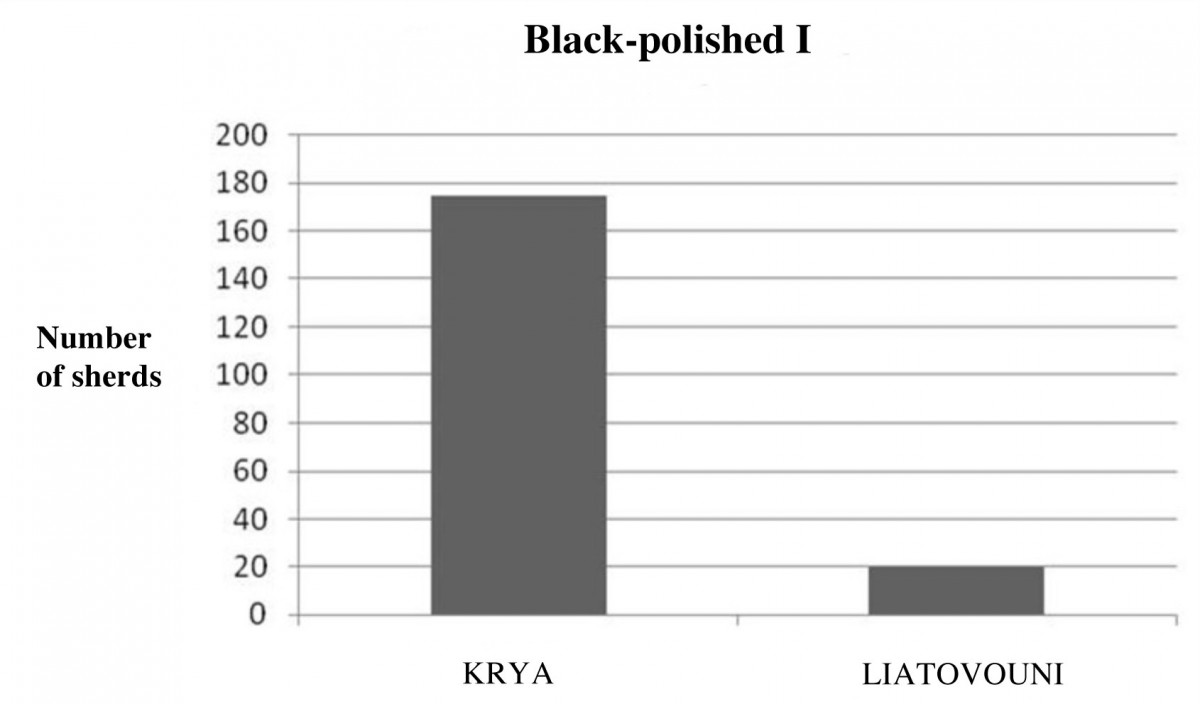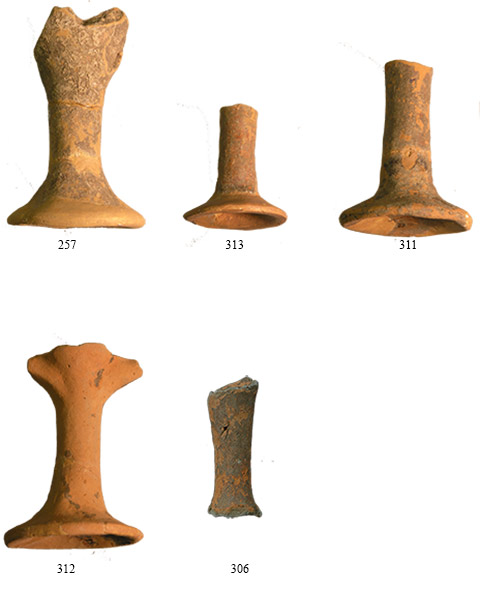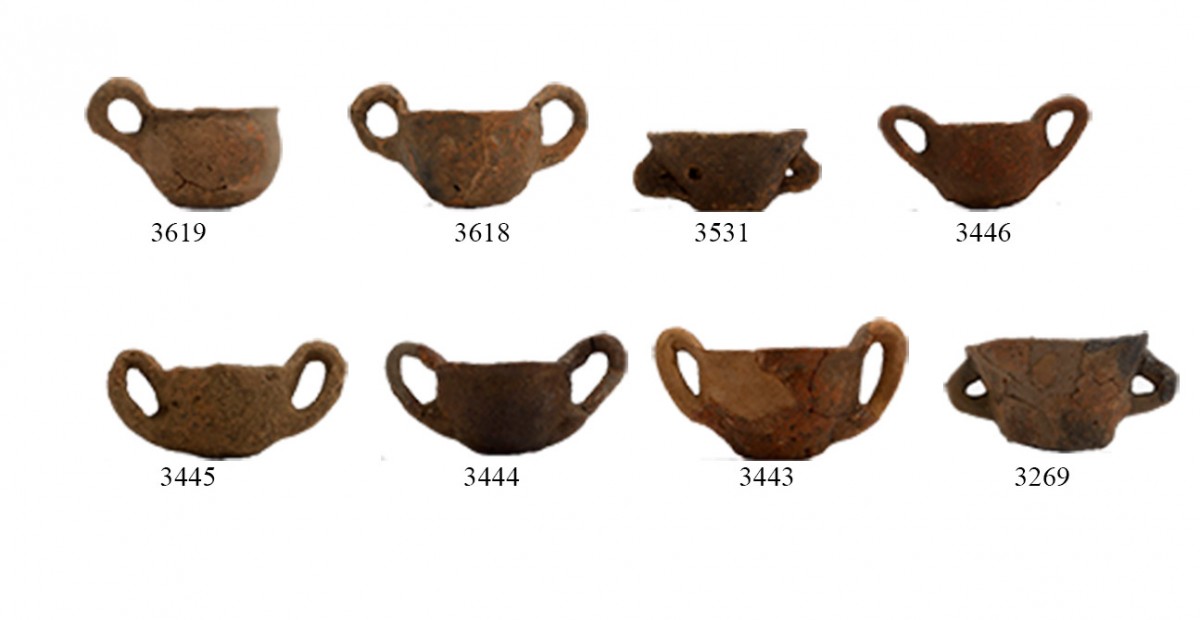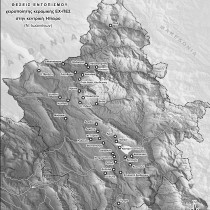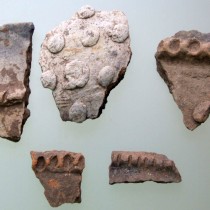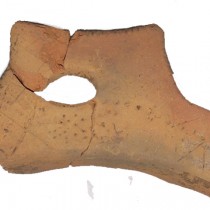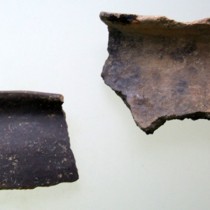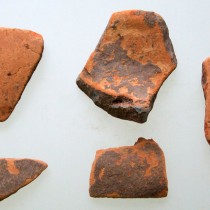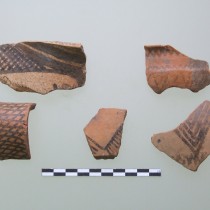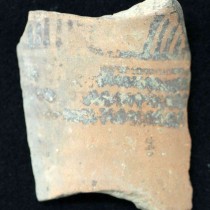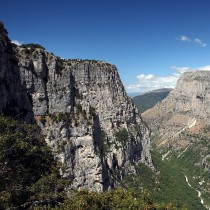The area of Central Epirus occupies the northwest part of the Greek peninsula. To the north it borders with Albania, to the east with the prefectures of Grevena, Kastoria, Kozani and Trikala, to the west with Thesprotia and to the south with the prefectures of Arta and Preveza. The pottery under consideration in this article originates from sites forming part of two geographical areas: the basin of Ioannina [Dodoni, Episcopi Servianon, Kastritsa, Kastro Ioanninon, Krya, Neochoropoulo (Palampouti and cist grave)] and the mountainous region (Vitsa, Elafotopos, Kalpaki, Kato Konitsa, Kato Pedina, Liatovouni, Mazaraki) (note 1) (fig. 1).
Typology (note 2)
After recording and classifying the material in categories based on the colour, the treatment of the surface and the presence or not of decoration, seven categories of pottery are identified: those whose decoration is plastic, impressed, monochrome, orange red, matt coloured and orange red with written black shiny decoration (fig. 2-8). At the same time, after sampling and carrying out delicate incisions on 122 sherds, it is found that potters used three groups of ceramic material in Krya and four in Liatovouni. In both cases it appears that the ceramic material was in use throughout the life span of the two settlements (note 3). The material from Episcopi Servianon is quite varied and cannot be grouped in specific categories, while there are general similarities found in the raw material for pottery-making at Kastro Ioanninon. The main decorative methods used by the potters of Epirus were plastic, impressed, incised and painted. Regarding ways of construction, most of the vessels seem to have been made with the “coil or ring technique” which is identified from the cracks in the vessels’ sides and particularly the joints of the coils.
The handmade pottery of Central Epirus can be divided into the following general categories regarding their alleged use: utensils used for multiple purposes (open-closed) or for cooking, food preparation and storage.
Dating
A delaying factor in shaping a local chronological sequence of ceramic categories is the absence of vertical stratigraphy in the sites of Central Epirus, combined with the inability to recognize changes in the morphological features of ceramic utensils from Bronze Age and Early Iron Age Epirus. Determining the pottery’s relative chronology, this was based on the stratigraphic sequences in those sites (note 4) on any radiocarbon dating available (fig. 9), and on similar typologies from neighbouring regions.
Regarding pottery with plastic decoration, based both on morphology (colour of outer surface) and technological features (ceramic material), a group seems to be formed with assemblages from area I in Dodoni (eastern part of sanctuary) (fig. 10), the vicinity of the drainage ditch in Kastritsa (fig. 11), Krya I (end of 12th c to end of 10th c B.C.), Palampouti (Neochoropoulo) and Elafotopos. Based on carbon dating from Palampouti (1730-1529 B.C.), the above group could chronologically begin during the Middle Bronze Age, continuing to the Late Bronze Age. A second group is made up of assemblages from Dodoni’s area II (western part of sanctuary) (fig. 10), the acropolis of Kastritsa, Episcopi, Kastro, Vitsa and Liatovouni. On the basis of stratigraphic data, this group can be dated from the beginning of the Early Iron Age.
Monochrome pottery seems to have continued the Neolithic tradition, as expressed in the ceramic assemblage from the site of Doliana, near the Greek-Albanian borders (Douzougli 1996, 117-119, Douzougli & Zachos 2002, 124-143). Such pottery is encountered in all the sites being studied. There is a variation, showing brown black to black colour, with a very smooth and occasionally polished outer surface (fig. 12) (note 5). This pottery variation is found in the following sites: Dodoni areas I and II, Kastritsa, Krya I, Liatovouni I, II (11th-10th c B.C.) and Elafotopos. Based on correlations of stratigraphy and typological similarities, this variation dates either from the Late Bronze Age, or the transition from the Middle to the Late Bronze Age.
The presence of intact examples of the matt-coloured I category in closed assemblages (graves in Kato Pedina and Kato Konitsa) (fig. 12) fairly confidently confirms its appearance in Epirus during the LHIIIC period. Orange red pottery of category I seems to have emerged at the same period or slightly after those of 6a. In Krya, Dodoni, and Liatovouni such pottery is found with matt coloured sherds.
According to offerings in graves of Liatovouni (Douzougli 1996, 20, 22, Douzougli and Papadopoulos 2011, 45-46), matt-coloured pottery dates from after the 10th c B.C. Based on statigraphy from Krya and Liatovouni, it appears that orange red II pottery started being produced in the same period as matt coloured II.
The organization of pottery production
Outlining the organization of pottery production is based on the parameters of standardization, work investment and skill. Standardization is analyzed in terms of shape, ceramic material, construction techniques and methods of decoration.
The repertoire of shapes in ceramics is relatively varied both in the Bronze Age and the Iron Age, possibly because utensils served a wide range of uses. It could be argued that pottery in Central Epirus during the Bronze Age was used exclusively for daily needs. Available data does not suggest the existence of special social practices and utensils that could be linked to such pottery. A handmade long stemmed cup (kylix) featuring very strong standardization, makes its appearance at the end of the Late Bronze Age. Its simultaneous use in numerous sites of the Ioannina basin is indicative of “mass production” exceeding the limits of domestic production and indicating technical expertise (fig. 13).
Recipes for making pottery seem to be transferred from generation to generation and remain unchanged over a long period of time. The technique of coils was followed when making large vessels, while the “pinching” technique was used for smaller ones. Regarding their surface treatment, most of the vessels are well smoothed and often covered by a coating or polish. A lack of kilns in the region of Central Epirus (note 6), as well as study of the ceramics’ technological features, suggest that vessels were fired in the open. In the field of decoration, standardization is observed in motifs, even among regions distant from each other. This leads to the hypothesis that there was either contact between producers of ceramics, or that potters were moving around to satisfy needs of many communities in an extensive geographic region. Adopting and implementing written matt coloured ceramic decoration seems to have been intentional, in the need for diversity in local communities of central Epirus. All vessels of matt coloured category I were handmade, like all products from the rest of local ceramic categories. Consequently, the vessels’ construction technique was familiar to potters and there is no reason to believe that it was imported. Technically it belonged to a type of ceramics that local potters could produce simultaneously with other categories of the Late Bronze Age.
Absence of polish from the greatest percentage of vessels from central Epirus was equivalent to the limited amount of time invested by potters. Thorough coating found on a considerable number of utensils required additional working time. The making of large jars presupposed craftsmanship, as did the decoration of the vessels’ outer surface with plastic decoration and specifically with written matt coloured motifs.
Consumption
An examination of the distribution of ceramic categories in domestic and burial assemblages in Central Epirus, shows the following results regarding their consumption:
Data from statistics indicates that examples of ceramics with plastic decoration were located only in settlements and mostly in those of the basin. Monochrome ceramics are encountered in both domestic and burial assemblages. They coexisted with those having plastic decoration, in all domestic assemblages of the Late Bronze Age in Central Epirus, the one type complementing the other (note 7). Orange red ceramics was created in the local potters’ effort to produce a category of delicately crafted ceramics similar to the ‘’Mycenaean’’ style. In time, they prevailed and gradually replaced the two main handmade local categories. The shape of the long stemmed cup was one of the potters’ most special creations. Vessels of the handmade version of the long stemmed cup was not found in any burial assemblage, either in the basin or the mountainous hinterland. Examples of matt coloured ceramics of categories I and II were located both in habitation complexes in the basin and in habitation and burial complexes in the mountainous hinterland. Phase I is more frequently recorded in settlements in the basin area, as proved by comparative data on the Liatovouni and Krya settlements (fig. 15). The fact that a collection of fifteen jars was found in the eastern part of Krya, in section VII, led to the conclusion that the practice of storage in the settlement took place in a specific area. In burial assemblages, it is observed that specific vessels repeatedly used for drinking (cups, kantharoi) and offering (prochoi, ladels), belong to the orange red and matt coloured ceramic category, usually co existing with jewellery and bronze weapons. Ceramic categories and types of vessels are used differently in the east and west parts of Dodoni. Specifically, in the east part, almost no shards were found either of orange red or matt coloured ceramics. Furthermore, a group of miniature vessels (cups and kantharoi), come from there and particularly from area Z of the temple of Themis , which, owing to their size, could not possibly have been of practical use (fig. 16). Most probably, a form of outdoor worship (note 8) was practiced in the eastern part of the Dodoni sanctuary during the Late Bronze Age–Early Iron Age.
Conclusions
In the Bronze Age, the small degree of standardization in the making of ceramics, combined with the absence of special places intended for its practice, was probably related to the fact that it did not result from intensive production. A deliberate diversity is noted in the shape of vessels, related to their practical use and a deliberate standardization in the ceramic material, surface treatment, decoration and firing. Tradition in Bronze Age ceramics was expressed through types both with plastic and monochrome decoration. The same technological processes were followed in the making of utensils. In regards to raw materials, potters throughout the entire Bronze Age, used the same clay for the making of vessels. The range of shapes was very conservative, with the same type of utensils repeated over the centuries. It appears that in each site, ceramic production aimed to provide for the needs of group members. However, based on data from individual graves, the situation seems to have changed at the end of the Late Bronze Age. The appearance of valuable objects among the offerings (bronze weapons, jewellery and Mycenaean ceramics) is indicative of elementary social stratification. Grave delimitation at strategic points inland is possibly linked to the emerging of a group of powerful individuals (warriors?), who gained strength from their ability to control the transport and circulation of precious goods.
The beginning of the Early Iron Age is marked by the appearance of two new ceramic categories, namely orange red and matt coloured. At the same time, the two ceramic categories from the Bronze Age continued to be produced and used. All categories of utensils were for the most part handmade, but significant changes were noted in the technology of their construction. A deliberate change is observed in the shapes of vessels, their decoration and intentional standardization in ceramic material, surface treatment and firing. Regarding surface treatment, most of the vessels continue to be extremely smooth, while often being covered with a coating or polish. Unlike the Bronze Age, light tones of colour (orange red, light brown, ochre brown) dominate the surfaces of vessels, a fact most possibly connected to the firing conditions and the use of different sources of raw materials. The ceramic matter used by potters for making the two new categories (orange red and matt coloured) was, to a great degree, the same and in some cases (mainly in Liatovouni) in common with the other two categories (ceramics with either plastic or monochrome decoration).There is not much change in the range of shapes, apart from the adoption of a few new types which, for the most part, were linked with the funerary ritual and belonged to the two new ceramic categories. The introduction of decoration is the most important innovation in the field of ceramic production, because it affected the structure of relations between the features of vases. It could be argued —based on the interaction between orange red and matt coloured, the creation of the hybrid type of cup/kylix and the use of raw materials found locally— that members of local societies had been trained in the technique of matt colouring. Now, a change is brought about in production organization, since certainly more time is required and new stages are added, such as selecting and finding raw materials for paint and designing the motif on the vase. Most probably, this marks the transition from non intensive to intensive production. Thus, an enrichment of material culture can be noted in the 10th c B.C. Choices of individuals increase, demands and needs of people expand. This is not an era of decline and isolation, but one of prosperity, progress and development.
Eleni Vasileiou
Archaeologist, Ephorate of Antiquities in Ioannina
* The present article is a summary of the doctoral thesis presented and approved at the Aristotelian University of Thessaloniki on 13th May, 2015. It was supervised by Dr Stylianos Andreou, professor of Prehistoric Archaeology, to whom the author wishes to extend her warmest thanks. Likewise, warm thanks are due to my teachers, Dr Konstantinos Zachos and Dr Angelika Douzougli.
